

Brave New World
High School Sports Features August 7, 2017 Clay Kallam 1

Examining CIF’s Shift To A Competitive Equity-Based Playoff System •
Story by CLAY KALLAM | Illustration by MIKE DECICCO
It used to be so simple: How many students a school had attending once determined what division it played in. But now it’s a brave new postseason world for high school teams — though more than a few coaches would substitute a different adjective for “brave.”
“For CIF, it’s about money,” says Campolindo-Moraga football coach Kevin Macy, an outspoken critic of the state system that places teams in postseason divisions based on competitive equity as opposed to enrollment. “They’re playing for the gate.”
Some facts: A few years ago, there were five state championship football games. Last year, there were 13. A few years ago, only a few state championship basketball games were televised; last year, all of them were.
“I believe they’re making decisions based on money,” says Ryan Reynolds, football coach at Sutter, pointing to a standing-room-only crowd when his school (enrollment 740) played at Oakdale (enrollment 1,700) in the 2016 3-A regional final. The final score was 27-10 Oakdale, which went on to defeat The Bishop’s School-La Jolla 47-0 in the state championship. Bishop’s has an enrollment of 800.
And of course, every postseason game generates income for CIF, both at the gate and from television. “They want more games,” says Kevin Hartwig, football coach at Freedom-Oakley. “In North Coast Section, it seems like everybody makes the playoffs.” The NCS makes money off every playoff game.
From the CIF perspective, money is a secondary consideration. The goal is to have competitive games in postseason, and with divisions based on enrollment, that simply wasn’t happening. In the Southern Section, the largest in the state, the new system that placed teams in postseason divisions by virtue of their achievements during the regular season resulted in closer games in every sport in which it was used. Rather than teams winning football games by 37 points a game (as in 2015), the margin dropped to 17 points a game.
With that in mind, state postseason bracketing now discards enrollment entirely, and focuses exclusively on competitive equity, on matching teams at similar levels, regardless of school size.
But especially in football, school size is an issue. In its 2016 season-opener, Campolindo, a 4-AA school, played Valley Christian-San Jose — which would play in the 2-AA state title game four months later. Macy said he lost four linebackers on the first possession. Valley Christian, though a small school, is private, and had 68 on its roster, including two 300-pound-plus players and five more that weighed 250 or more pounds. Campolindo had one player who weighed more than 220 pounds.
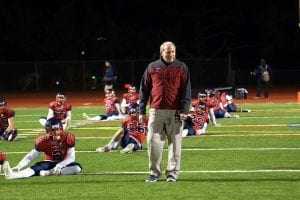
Kevin Macy paces among players prior to a CIF NorCal Bowl again Milpitas in 2015.
Macy scheduled the game in response to 2015 CIF matchups against Milpitas (3183 enrollment) and La Mirada (1700).
“We can compete with a 50-pound mass index disadvantage,” says Macy, “but a 100-pound mass index disadvantage is out of our range. I don’t mind losing, but I don’t want to lose players.”
“Part of my frustration with CIF is that they look at everything on paper,” says Reynolds. “If they walked on our campus, they’d have a completely different perspective.”
For Reynolds and others, it means all numbers are not created equal. Sixty players on a roster for a public school does not equal 60 players for a private school, especially one with a reputation for excellent football. De La Salle, for example, has an enrollment of just over 1,000 boys, but routinely punishes schools that can draw from male student bodies twice as large.
But competitive equity isn’t just about football. Basketball and girls volleyball have moved further down that road with a momentous change that has yet to register with many coaches. Sections will no longer determine what NorCal and state division their teams play in; that’s now up to a CIF committee.
In the past, if a team qualified for postseason in basketball, unless it was bumped to the Open Division, it competed in its section-assigned division. So if Bishop O’Dowd, a Division III team in girls basketball according to NCS, qualified for NorCal basketball but wasn’t an Open team, it would automatically drop back to Div. III for NorCals and state.
No more. Now the state committee will take all teams that qualify for regional play and rank them top to bottom — regardless of division, regardless of enrollment and regardless of tradition. The top eight are Open, and the next 16 are Division I. Teams 25 through 40? Division II, even if team No. 38 was a Division V section champion and has just 200 students.
“We want to set up a tournament that’s competitive,” says Ron Nocetti, associate executive director of the California Interscholastic Federation. The size of the school? “It just doesn’t matter. We take the rankings of each section and create the matchups. The best should play the best. That’s their competitive level — that’s the concept.”
But Shawn Hipol, the St. Joseph Notre Dame-Alameda girls basketball coach, is concerned how the committee will figure out who’s best.
“Are they really going around on Tuesday and Friday nights to see St. Joseph Notre Dame play Head-Royce?,” Hipol asked. “They’re not going to have eyes on all the teams.
“I just don’t want to be on the bottom of the barrel to fill out the bracket,” Hipol added, while at the same time acknowledging he wouldn’t shy away from competition. “If we’re good enough, then I want to play competitive games in the first round.”
True, but let’s go back to Campolindo, but in a different sport. The Cougars girls volleyball team dominated the Diablo Athletic League in 2016, going 10-0 and losing just two sets along the way. Because of that success, Campolindo was placed in the Open Division, and lost in the second round to St. Ignatius-San Francisco, a private school that’s a magnet for elite volleyball players.
Acalanes-Lafayette, which lost twice to Campolindo without winning a set, won a Division III state title.
“Our girls got punished because they’re better?” asks Macy, a question that makes sense if the goal is to win a state championship, as opposed to playing against the best possible postseason competition and thus likely losing along the way.
“They’re trying to make things fair by taking Campolindo out of the mix,” says former longtime Deer Valley volleyball coach Lou Panzella, “but is that fair to Campo?”
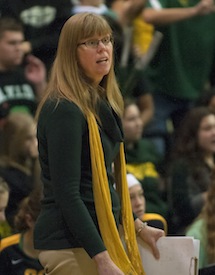
Kim Evans coaches during Sonora’s 2014 CIF State Championship.
From the CIF perspective, the answer is a clear ‘yes’. “It’s not always about winning or losing,” says Nocetti. “We’re focusing on the experience.”
Coaches, players and fans are more focused on winning.
“I don’t think it’s good for high school sports,” says Kim Evans, who coached volleyball at small-school power Sonora for nine years. “I think it’s a disservice. Your high school and fan base don’t even know about Open and divisions. They just know you lost. A team can be super good and not win a state title.”
She points to the public-private divide as part of the problem, as private schools have an enormous inherent advantage because they can attract athletes for all sports without regard for the attendance areas public schools must adhere to. With private schools’ abundant athletic success, those winning teams — especially state championship teams — are free marketing.
Speaking of state championships, it is becoming more clear to coaches that if the goal is to win one, then staying out of the Open Division will increase a team’s chances exponentially.
“The best thing a team can do is find some appropriate losses,” says Macy.
Longtime St. Joseph Notre Dame boys basketball coach Don Lippi agrees: “You’re going to have some scheduling shenanigans. I’ve talked to some girls coaches who want to schedule the stronger teams so they can avoid the Open.”
“It’s different in the boys,” Lippi continued, echoing a sentiment expressed by others. “The talent is more divided.”
On the girls side in both volleyball and basketball, the presence of such perennial powers as Archbishop Mitty-San Jose, and its plethora of Power 5-bound athletes, is more daunting.
Lippi, whose program has won two of the last three Div. V state titles, could be one of those most affected by the new system. Yet he’s all for it. “It’s the most fair it’s going to be,” he says as he heads into his 39th year of coaching. “If somebody’s dominating a division, they shouldn’t be in that division.”
“We’re having more successes than failures,” says Nocetti of the gradual implementation that’s taken place over the past several years, “and we think we’ll get even better.”
Even Reynolds, who is critical of the football framework, agrees. “I do like it,” he says, “but it’s a work in progress.”
And as for complaining coaches? “Coaches are going to be coaches,” says Nocetti, “and they will adapt and adjust — to change would be moving backward (for CIF).”
In this brave new world, moving backward isn’t an option.


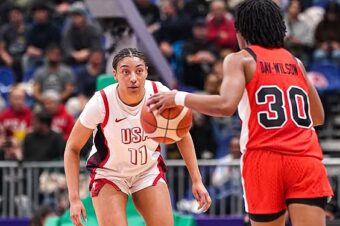
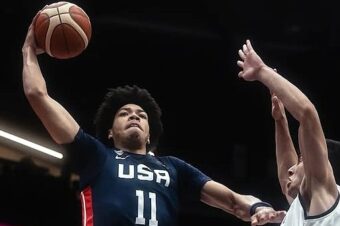

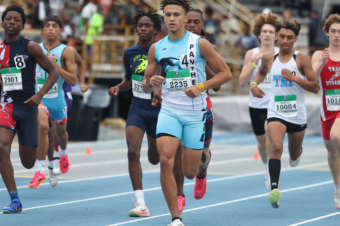

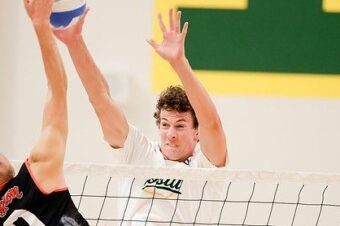

roger newell
August 12, 2017 #1 AuthorHope CIF plans to move basketball Championship games back to Nor Cal [at Cal or Oracle]. Sacramento is simply – second rate and attendance
numbers would substantiate.